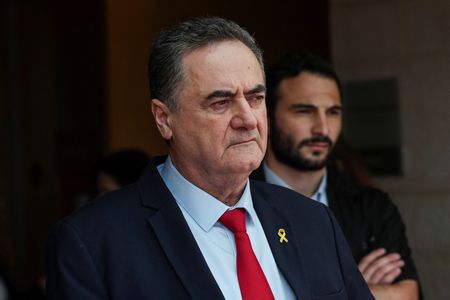WASHINGTON (Reuters) – U.S. President Donald Trump said on Wednesday he would add new tariffs to his sanctions threat against Russia if the country does not make a deal to end its war in Ukraine, and added that these could also be applied to “other participating countries.”
In a post on Truth Social, Trump modified comments he made on Tuesday that he would likely impose sanctions against Russia if President Vladimir Putin refused to negotiate an end to the nearly three-year conflict.
“If we don’t make a ‘deal,’ and soon, I have no other choice but to put high levels of Taxes, Tariffs, and Sanctions on anything being sold by Russia to the United States, and various other participating countries,” Trump said.
Trump’s post did not identify the countries that he considered participants in the conflict, or how he defined participation.
Former President Joe Biden’s administration heaped heavy sanctions on thousands of entities in Russia’s banking, defense, manufacturing, energy, technology and other sectors since Moscow’s February 2022 full-scale invasion of Ukraine, which has killed tens of thousands and reduced cities to rubble.
Russia’s deputy U.N. Ambassador Dmitry Polyanskiy said Moscow will have to see what Trump thinks a “deal” to end the war in Ukraine means.
“It’s not merely the question of ending the war,” Polyanskiy told Reuters. “It’s first and foremost the question of addressing root causes of Ukrainian crisis.”
In the runup to his Nov. 5 election victory, Trump declared dozens of times that he would have a deal in place between Ukraine and Russia on his first day in office, if not before. But Trump’s aides have conceded a deal to end the war could take months or longer.
Earlier this month, the U.S. Treasury hit Russia’s energy revenues with its hardest sanctions yet, targeting oil and gas producers Gazprom Neft and Surgutneftegas, as well as 183 vessels that are part of the so-called dark fleet of tankers aimed at evading other Western trade curbs.
SANCTION AND TARIFF THREATS
Trump has sought to use the threat of tariffs to achieve non-trade goals, including threatening Mexico, Canada and China with duties to push them to stop illegal migration and the flow of the deadly opioid fentanyl into the United States.
Those three countries are the top U.S. trading partners. But Russia is far down the list, with U.S. imports from Russia falling to just $2.9 billion through the first 11 months of 2024 from $29.6 billion in 2021.
The U.S. stopped importing Russian oil after its invasion, but still imports some precious metals, including palladium used in automotive catalytic converters.
As for other participants, the Biden administration had imposed sanctions against entities in China, North Korea and Iran for aiding Russia’s war effort.
Trump said he was “going to do Russia, whose Economy is failing, and President Putin, a very big FAVOR. Settle now, and STOP this ridiculous War!”
The negotiating positions of the two warring sides remain far apart, and some Ukrainians fear they could be forced to make massive concessions after three years of brutal combat.
The conflict has developed into a war of attrition largely fought along front lines in eastern Ukraine, with huge numbers of casualties on both sides.
(Reporting by Ismail Shakil and David Lawder, Katharine Jackson; additional reporting by Michelle Nichols at the United Nations and Daphne Psaledakis in Washington; editing by Rami Ayyub, Rod Nickel and Don Durfee)











